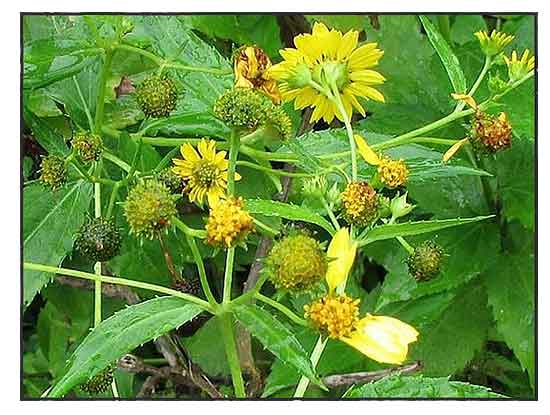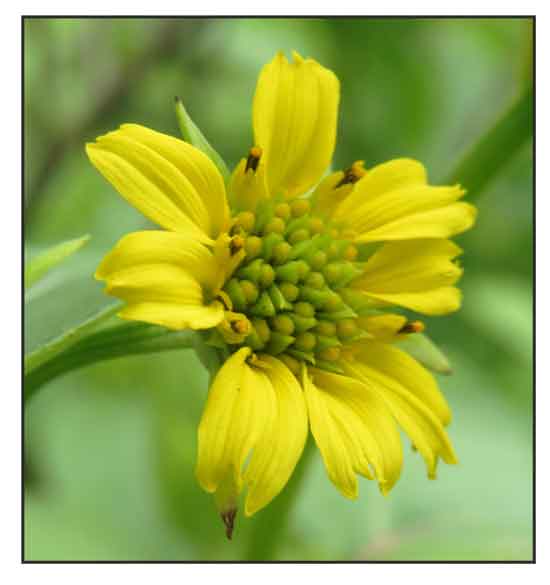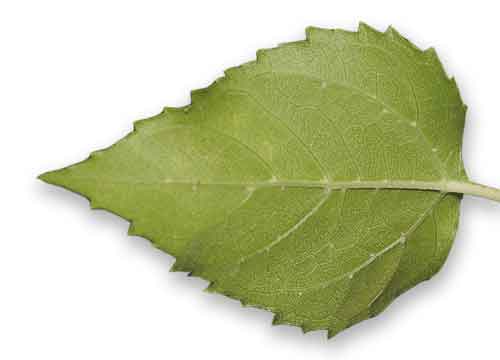
Gen info
- Wollastonia is a genus of flowering plants in the family Asteraceae. It includes 8 species which range from Mozambique and KwaZulu-Natal in southeaster Africa to western Indian Ocean, tropical and subtropical Asia, Australia, and the Pacific Islands. (5)
- The most common species of the genus is Wollastonia biflora, which is one of the first species colonizing degraded or altered environments in tropical zones of the planet.
Botany
• Hagonoi is a climbing, rough,
herbaceous vine. Leaves are opposite, ovate, 6 to 8 centimeters long, with pointed
tips and rounded bases, rather coarsely toothed margins. Stalks are
3 to 6 centimeters long. Head are 3 centimeters in diameter, numbering 1 to 3, sometimes more, in the upper axils, with stalks
about 7 to 10 centimeters long. Involucral bracts are narrowly oblong, somewhat
recurved, hairy, and equaling or exceeding the disk. Ray flowers are 6 to 15, the ligule oblong, yellow, 3-toothed, and 6 to 12 millimeters long. Disk flowers are numerous, yellow, or yellowish-brown.
 Distribution Distribution
- Native to the Philippines.
-
Usually abundant in thickets of beaches and
along tidal streams throughout the Philippines.
- Also native to Andaman Is., Assam, Bangladesh, Bismarck Archipelago, Cambodia, Caroline Is., Chagos Archipelago, China South-Central, China Southeast, Christmas I., Cocos (Keeling) Is., Comoros, Cook Is., East Himalaya, Fiji, Gilbert Is., Hainan, India, Jawa, Kazan-retto, KwaZulu-Natal, Laos, Malaya, Maldives, Marianas, Marshall Is., Mozambique, Mozambique Channel Is., Myanmar, Nansei-shoto, New Caledonia, New South Wales, Nicobar Is., Niue, Norfolk Is., Northern Territory, Ogasawara-shoto, Queensland, Samoa, South China Sea, Sri Lanka, Taiwan, Thailand, Tibet, Tonga, Tubuai Is., Tuvalu, Vanuatu, Vietnam, Wallis-Futuna Is. (9)
 Constituents Constituents
- Study of whole plant of Wollastonia biflora isolated three new germacrane-type sesquiterpenes (1-3), two new pimarane-type diterpenes (4,5) and a new naphthalene glycoside (6) along with 11 known compounds. (see study below) (12)
- Study of flowers yielded six new phenolic glycosides (wedebicoside A - F [compounds1-6]) and one new ceramide, wedebiceramide (9), together with six known compounds, 1-O-(2,4-diangeloyloxy-beta-D-fucopyranosyl)-6-hydroxythymol (7), 1-O-[2,4-diangeloyloxy-3-(3"-angeloyloxy-beta-D-fucopyranosyl)-beta-D-fucopyransyl]-6-hydroxythymol (8), anhydrosecoisolariciresinol (10), friedeline (11), epifriedelanol (12) and stigmasterol (13). (see study below) (13)
- GC-MS analysis of volatile oil yielded 72 components. Sixty-eight were identified accounting for about 98.51% of the total chemical constituents, mostly sesquiterpenoids. Main constituents were D-limonene (15.40 %); 4,11,11-trimethyl-8-methylene-[1R-(1R*,4Z,9S*)]- bicyclo[7.2.0]undec-4-ene (9.70 %); 1R-α-pinene (8.94 %); 4-methyl-1-(1-methylethyl)-didehydro derive bicyclo[3.1.0]hexane (8.07 %); 1-methyl-3- (1-methylethyl)-benzene (6.71 %); 1,1,4,8-tetramethyl- cis, cis, cis-4,7,10- cycloundecatriene (5.39 %); germacrene D (4.65 %), among others. (14)
- Phytochemical screening of ethanol extract of leaves revealed alkaloids, sugars, flavonoids, tannins, terpenes, proteins, carbohydrates, coumarins, with absence of steroids, anthraquinone glycosides, and cardiac glycosides. (17)
- Phytochemical screening of ethyl acetate extract of flowers yielded alkaloids, flavonoids, phenol, steroid and tannin, with absence of saponin. Fresh flowers in distilled water yielded flavonoids, phenol, saponin, steroids, with absence of alkaloids and tannin. The n-hexane extract of whole plants yielded alkaloids, flavonoids, steroids, with absence of phenol, saponin, and tannin.
(19)
-
Study of methylene chloride extract of dried leaves isolated four compounds: veratrylidenehydrazide, 3,3′-di-O-methylquercetin, 2,7-dihydroxy-3(3t'-methoxy-4′- hydroxy)-5-methoxyisoflavone and 3′,7-di-O-methylquercetin. (see study below) (21)
Properties
- Considered emmenagogue, diuretic, stomachic.
- Leaves considered vulnerary.
-
Roots are stomachic,
leaves are diuretic and vulnerary.
- Studies have suggested antifeedant, antifungal, analgesic, antimicrobial, anthelmintic, antiplasmodial, anticancer, antibacterial properties.
Parts
used
Roots, leaves, flowers.
 Uses Uses
Edibility
- Despite the rough appearance of the plant, the leaves are edible.
-
In Malaysian cuisine, shoots are eaten, cooked as leaf vegetable; in Langkawi, eaten raw with chili and sambal shrimp paste. (15)
-
Plant used as substitute for tea.
- Fresh roots and leaves prepared as tea have diuretic effects. (20)
Folkloric
- In the Philippines, roots used as stomachic, and the leaves as diuretic.
- Flowers heads are a violent purgative. Resh or cooked roots used as stomachic, febrifuge, emmenagogue, for checking vaginal discharges, and for chest tightness, and dizziness caused by eating poisonous fish and crab. (20)
- Leaves prepared as tea are antiperiodic in malaria, used as a cure for hematuria, muscle aches, and headaches. (20)
- Fresh leaves used for dressing ulcers and abscesses. In Malaysia, used as poultice
for varicose veins and insect bites. Juice of leaves mixed with cow's milk given as tonic after childbirth. Mixed with ginger, it is use to treat flatulence. (20)
-
Decoction of roots
is slightly purgative.
- Used with Blumea balsamifera for baths.
- Leaves in decoction are antiscabious.
 - Decoction of roots and leaves for stomach aches and fevers. - Decoction of roots and leaves for stomach aches and fevers.
- Leaves used for cleaning and dressing ulcers.
- Juice of leaves, with cow's milk, taken as tonic after childbirth.
- Decoction of leaves with ginger for flatulence. The same preparation used for venereal diseases in Singapore.
- Decoction of leaves used as antiperiodic in malaria and in hematuria.
- Flowers are known to be a violent purgative.
- Plant is used for headaches and fevers.
- Roots used to check vaginal discharges.
- In Lower Thailand used for headache and fever.
- In New Caledonia, juice of leaves in water used as remedy against children's dysentery. Also for diarrhea caused by cold exposure while fishing.
- Elsewhere, poultice used for cuts, ulcers, sores, varicose veins, stomach aches.
- In the Marshall Islands, pounded fresh young leaves placed in a sanitary pad applied for excessive vaginal bleeding. One flower and one leaf bud chewed by women to hasten childbirth. Leaves pounded with grated coconut and rubbed on the child's body after bathing to treat skin rashes. Chewing of stems or stem juice used for fish poisoning. (10)
- In Southeast Asia, leaf decoction used for relieving periodic fevers.
- In Fiji, leaves used for treatment of acne.
- In Tamil Nadu, India, leaves are used for treating wounds, ulcers, sore throat, varicose veins, skin diseases, headache and stomach ache. (16)
Folkloric
- Fodder: Plant used as fodder for rabbits.
- Veterinary concern: Old stems and leaves reported toxic, and can cause vomiting in horses and goats, even death. (20)
Studies
• Antifeedant / Antifungal Activity / Stems and Leaves:
Cotton boll weevil antifeedant activity and antifungal
activity (Rhizoctonia solani and Pythium ultimum) of extracts of the
stems of Wedelia biflora: Extracts showed antifeedant
activity which led to an investigation of antifungal properties. (1) Study of methylene chloride extract of dried leaves isolated four compounds. The third compound possessed antifungal and boll weevil antifeedant activity while the fourth showed antifungal activity. (see constituents above) (21)
• Analgesic
Activity: Comparative study on analgesic activity of
ethanol extracts of Wedelia biflora, W trilobata and E alba showed significant
antinociceptive activity in a dose-dependent manner in mice comparable
with standard drugs such as aspirin. (2)
• Phytochemicals: Phytochemical screening yielded alkaloids, steroids, sugars, tannins, terpenes, proteins, carbohydrates, coumarins, anthraquinone, glucosides and cardiac glycosides. (3)
• Antimicrobial / Anthelmintic: Alcoholic and aqueous root extracts were evaluated for anthelmintic and antimicrobial activities. Both extracts showed anthelmintic activity against adult Indian earthworm, Pheretima posthuma. The ethanol extract was more potent than the reference control Piperazine citrate. The ethanolic extract showed maximum antimicrobial activity against tested organisms. (6)
• Antimicrobial / Wound Healing / Leaves: Study of an ethanol extract of leaves in in vitro assays showed antimicrobial and wound healing activities in excision and incision wound model in Wistar albino rats. In the treatment group, there was greater wound healing and higher collagen redeposition. (7)
• Antiplasmodial: Sernai leaves (Wedelia biflora) extracts of leaves exhibited antiplasmodial activity against Plasmodium berghei on mice infected experimentally. (8)
• Cytotoxic / Sesquiterpenes: Study of whole plant yielded three new germacrane-type sesquiterpenes (compounds 1, 2, and 3) which showed significant cytotoxic activity against the growth of hepatocellular carcinoma BEL-7402 cells in vitro. (see constituents above) (12)
• Anticancer / Phenolic Glycosides / Wedebicosides: Study of flowers yielded six new phenolic glycosides (wedebicoside A-F:compounds 1-6) along with seven other compounds. Compounds 1, 2, 3, and 5 showed strong cytotoxic activities against three surveyed cancer cell lines viz. HeLa, MCF-7 and NCI-H460. (see constituents above) (13)
• Antibacterial / Whole Plant: Study evaluated the antibacterial activity of Wedelia biflora using agar well diffusion method. The methanol extract of whole plant exhibited antibacterial activity against Gram(+) Bacillus cereus and Staphylococcus aureus and negative effects against Gram(-) Pseudomonas aeruginosa and Escherichia coli. Activity was concentration dependent, and only concentration of 1000 mg/mL exhibited moderate activity against B. cereus. (16)
• Reflex Righting in Induced Central Pain / Leaves: Study showed administration of leaf extract in rats had a positive effect on erythrocytes, leucocytes, and hemoglobin with best results at dose of 50 mg/kbw. Central pain test was carried out using tail immersion method and hot plate, while righting reflexes were observed from 30, 60 120, 140, and 360 minutes after being given sernai leaf extract. Results showed W. biflora leaves exhibited analgesic effect without altering the blood profile, and also showed positive effect on reflex righting. (18)
Availability
Wild-crafted. |


![]()

